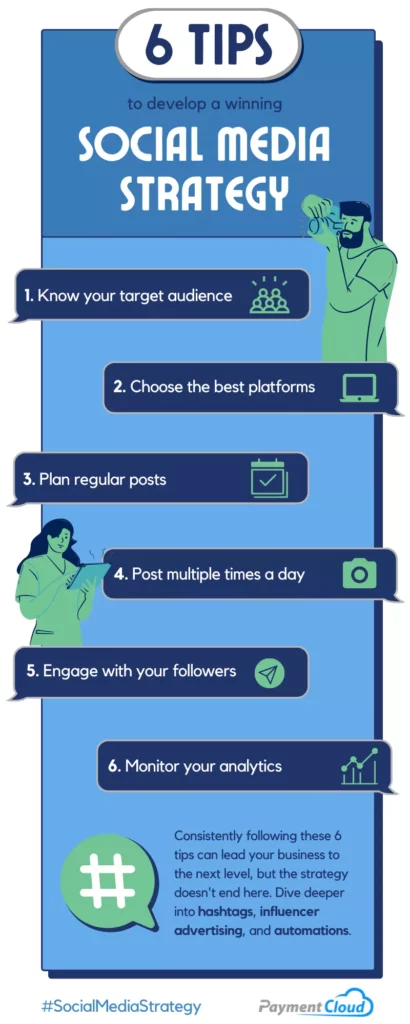
TABLE OF CONTENTS
- What Is Social Media Marketing?
- Benefits of a Social Media Marketing Strategy
- How to Develop a Social Media Strategy in 6 Steps
- Best Social Media Marketing Platforms
- Creating Content for Social Media
- How to Advertise on Social Media
- The Best Tools for Managing your Social Media Marketing Efforts
- Final Thoughts on Social Media for Business
- Social Media Marketing FAQs
Social media marketing advertisement spending is predicted to exceed $200b annually by 2024, so it’s no wonder this is now one of the primary arenas for attaining new customers.[1]Statista. “Social media marketing worldwide – statistics & facts“. Accessed July 6, 2022. Whether you own a physical store that needs to find nearby customers or want to start an eCommerce business that aims to target consumers in every corner of the globe, social media marketing can help.
In this guide, we explore social media marketing, its benefits, and a host of other related topics. By using the tools in this guide, you can start your social media journey on the right foot!
What Is Social Media Marketing?
Social media marketing is a form of digital marketing that involves either paid ads or organic posts on social media platforms. This type of marketing utilizes the power of social networks to build brand recognition, sell products, advertise events, and interact with customers or followers. Facebook, Twitter, TikTok, and various other social media platforms are all popular channels for this form of marketing.
Benefits of a Social Media Marketing Strategy
There are many reasons why developing a social media marketing strategy can improve your business. By investing time and resources in building your social media advertising platform, you can take advantage of the following benefits:

Engage with your target customers
Engaging with customers can build trust and help form long-term relationships. Social media allows you to directly communicate with your target audience, while also using it as a customer support tool. Whether your engagement is via posts that interest your customers or replying to comments on your social media pages, you can make customers feel part of your brand if you have a direct communication channel available.
Drive traffic to your site
If you have a website that you use to engage with customers, sell products, or conduct any other business activities, a social media presence can improve your website traffic. It’s easy to place links and all the calls to action (CTAs) on your social media posts to direct potential customers to your online store or general business website.
Support other marketing efforts
While many businesses use social media as one of their primary advertising channels, it can also play a support function. For example, if your business is hosting an event to promote your brand or products, using social media is an excellent way to inform followers about the event.
Platforms like, Facebook allows you to create an event, send invites, collect RSVPs, host event details, and more. Additionally, Instagram, YouTube, and others have a live stream tool that you can use to stream live events.
Increase brand awareness
A social media strategy can help you increase your brand awareness and tell your brand’s story. It’s hard to think of a large business that doesn’t have a massive presence on the leading social media platforms. Nike, Lululemon, Apple, Dell, and thousands of other leading brands all use social media to increase brand awareness.
By using social media to engage with consumers, post ads, and create exciting content, you can improve your brand recognition. In fact, there are many brands that built their entire existence using social media.
Cost-efficient advertising
Social media is one of the most cost-efficient ways to advertise. Creating an account on major social media platforms is free, as is posting your content and engaging with your followers. If you really want to gain traction, you should consider paid advertising campaigns. In reality, the ROI on efficient paid advertisements tends to be worth the investment. Either way, whether you choose to run paid campaigns or not, social media is a low-cost way to advertise your business and services. Why wouldn’t you take advantage of that opportunity?
How to Develop a Social Media Strategy in 6 Steps
If your business is new to social media, it can be difficult to understand where to start. Below, we take a closer look at six simple steps you can take to develop a social media strategy:
1. Know your target audience
You can’t develop a comprehensive social media strategy without understanding your target audience and utilizing their characteristics to create clear social media messaging. One of social media’s powers is connecting businesses with appropriate customers. For this reason, you need to understand your current customers and the customers you want to target in the future.
If you already operate a business, then explore the types of people that purchase your products or services. For example, if you own a skateboard business, targeting skaters within the correct age range is a good starting point. Social listening tools can save you time by crawling the web for you.
Let’s take a look at some audience metrics to help you identify your target consumer:
- Age
- Gender
- Location
- Previous purchases
- Interests
- Education
Knowing your audience will help you produce better content, and it will come in handy if you start paid ad campaigns on social media.

2. Choose the best social media platforms for your business
With various options to choose from, it’s critical to choose social media companies that have users who benefit from your product or service. For example, in recent years, research suggests that 34% of Facebook internet users are 65+ years old, which is much higher than Instagram’s 65+ user rate. Therefore, if you run a business that targets seniors, you will have a much larger target audience on Facebook.
Regardless, many business owners choose a multi-pronged approach when it comes to social media. By using most platforms, you can ensure you don’t miss out on any potential customers. While this might sound like a lot of work, there are now third-party applications that help you post to many social media channels simultaneously.
3. Plan regular posts
By planning routine posts, you can rest assured that your business has enough content to keep customers engaged. Many social media managers will develop content schedules that ensure a constant flow of posts on Facebook, Twitter, Instagram, and other leading platforms.
Also, many social media networks allow you to automate the process of uploading new posts, regardless of whether your social media manager is on the clock. This is an excellent solution if you want to post outside of regular business hours or make the uploading process less manual.
4. Post multiple times a day
While it might sound like too much, posting multiple times a day is the best way to improve engagement. If you don’t believe us, head to Facebook or Instagram, type in your favorite brand, and see how many posts the brand makes on a daily basis. Constant engagement is now the industry standard.
As previously mentioned, you can schedule posts in advance, so you won’t need to manually post content multiple times a day.
5. Engage with your followers
Social media allows direct communication with customers through posts, comments, likes, private messages, and other tools. If you do decide to use social media, don’t be dormant. You will need a social media manager (or maybe an entire team) to make sure that you get the most consistent engagement.
Engaging with followers can increase brand awareness, and it can also increase customer expectations. For example, nearly 80% of customers expect a business to respond to a social media post within 24 hours.[2]Sprout Social, Inc. “Social Media Trends for 2022 & Beyond“. Accessed July 6, 2022. Therefore, making sure that you are active on your social platforms will build strong relationships with your target audience.
6. Monitor your analytics
Lastly, it’s critical to monitor your analytics as routinely as possible. One of the best features associated with social media marketing is that you can view various metrics in real-time.
For example, on Facebook, you can track:
- Ad impressions
- Demographics
- Viewer location
- Video views
- Video percentage watched
These metrics help you determine the effectiveness of your posts, which makes it easier to create targeted ads in the future. Never underestimate the power of reviewing your analytics and adjusting your strategy based on success and failure.
Best Social Media Marketing Platforms
Many social media marketing platforms are popular throughout the United States and the rest of the world. Below, let’s look at some of the most powerful social media companies and what they offer to businesses:
Facebook continues to be the powerhouse of the social media industry. With more than two billion worldwide users and an ad platform that can help you target various niches, it’s no wonder this has become one of the most successful marketing platforms in history.
With Facebook, it’s easy for customers to set up a page, post questions, review your products or services, and more. You can also run highly-sophisticated ad campaigns and track metrics with ease. Additionally, you can utilize Facebook Pay, a peer-to-peer payment solution so customers can directly pay for services or products through the Facebook app.
YouTube
YouTube, which is owned by Google, is the world’s largest video-sharing social media network – more than five billion videos are watched every day on the platform. As with other social media platforms, you can choose to pay for ads on YouTube or develop your own content. Many businesses use YouTube as an educational resource. If you sell a product or service, your YouTube channel can host videos with tutorials, suggestions, and more.
YouTube also has a range of influencers that you can collaborate with. Many leading companies have brand partnerships and collaboration agreements with influencers. Many of these influencers have tens of millions of loyal followers and can be an excellent asset to your business.

While Instagram is owned by Facebook, there’s no doubt that Instagram has its own user base and content style. This means it’s critical to have a presence both on Instagram and Facebook. As of 2021, there are nearly 138 million Instagram users based in the United States. With such a huge user base, selling on Instagram is an absolute must for brand awareness.
Not only is Instagram an excellent platform for building a profile and paying for advertisements, but it’s also perfect for engaging with social media influencers. Instagram has become the unofficial hub of influencers, many of whom have loyal followings. Using their reach via paid product placements and other influencer marketing activities is an effective way to tap into new markets.
TikTok
TikTok is a Chinese social network with a large presence in the United States. The platform became famous for its unique video editing software, which allows users to create short, fun, creative clips with a range of filters and other features.
Over the past few years, TikTok has become one of the leading social media platforms, especially for younger generations. At the time of this publication, it has one billion monthly active users globally. Businesses place advertisements, use influencers, and generate their own content using TikTok.
LinkedIn is a social media application targeted toward professionals. Individuals create profiles that display their education, work experience, skills, references, and more. With a user base of 775 million, it has become a major hub for both networking and job searching.
Likewise, it’s now a major place to build brand awareness and recruit potential employees. If you want to increase your brand recognition, LinkedIn is an excellent tool. However, there is less of a focus on selling products and services unless your services are related to professional development.
Pinterest is a social media platform that boasts over 400 million monthly worldwide users. This is a unique social media platform that allows users to build pinboards with images, GIFs, and other forms of media. Many businesses are now using Pinterest to generate revenue.
While there’s no stopping your business from starting an engaging pinboard on the platform, you can also use Pinterest’s powerful ad platform to place ads on the network directly. As Pinterest boards often involve products and brands, it’s an excellent way to expose potential customers to new products and trends.
With over 200 million users, Twitter is another extremely popular social media platform. While Twitter isn’t as reputable for its content variety, it is still an essential marketplace for engaging with customers.
Twitter has been notoriously unsuccessful at creating a similar marketing machine to Facebook and other rivals, but it’s still a platform of choice for many Americans. Using Twitter for customer support, updates, and traditional ads is a perfect way to increase engagement. One of Twitter’s primary strengths is that it’s quick and consumable so you can provide real-time updates to your customers or followers.
Creating Content for Social Media
Creating effective and engaging content for social media can help you increase interaction with your customers. Content doesn’t need to contain sales pitches or any direct advertising – it can simply provide valuable information or entertainment to potential clients. By growing your brand into an authority in your niche, you can build long-term recognition that helps increase future revenue.
Types of social media content
If you explore the social media accounts of the top brands on the internet, you will find they have a range of different content types. Producing a range of content will connect to various types of consumers. Let’s take a look at three primary types of social media contact shared by businesses:
Blog content
Blog content is an excellent content option for businesses that want to engage with customers on social media. Many companies write long posts on their website and use their social media accounts to direct readers to their blogs. Search for topics in your niche and develop relevant content for your target audience. Prompt your followers to engage with your written content by asking them to respond in the comment section.
Also, using your customer queries to develop blog content can also be helpful. For example, if customers ask similar questions about a specific product, you can write a blog that clarifies any confusion.
Video content
While there is no doubt that blogs are a useful tool, many marketers believe video is a more effective content format. While video can help you immediately grab the viewer’s attention, you still need to make sure it’s entertaining enough to keep the user’s attention. Social platforms also allow you to track how many views you are getting for each video.
One thing about video content is it can also be expensive. Many social media advertising teams have in-house video producers, but you can also outsource this task to a third-party company.
Images and infographics
Images and infographics are excellent hybrid content options for businesses. With infographics, you can provide information that is more appealing than traditional text.
You can bring your content to life by mixing text with helpful images. Whether it’s graphs, cartoon characters, photos, or a mixture of all three, make sure you create infographics that your target audience will enjoy.
Trending content
Keeping up with trends is key for this, and social media channels are ideal for picking out topics that are gathering momentum. You might question the suitability of many trends, but it’s almost always possible to connect two topics. Because identified trends are determined by the interests associated with the logged-in account, be sure to use an account that’s professionally invested. Look through the trends on a daily basis, and consider a simple question: “What would people like to read about?”. Not only does this draw in new audiences, but it also increases your site’s click-through rate. The more traffic your site receives the more likely you are to increase sales.
In the case a subject that people don’t really understand comes up, you can explain it. If there’s a pop-culture event on everyone’s mind, you can find a (tasteful) riff on it. Unfortunately, trendy content doesn’t retain its value for very long. If you track the value carefully and adjust your approach accordingly, it will be a huge addition to your strategy.
How to Advertise on Social Media
Developing your presence on social media involves two primary channels: paid ads and organic posts. With organic posts, you use your public business page to post videos, photos, links to blogs, and various other types of content. In most cases, this is entirely free – and individuals that follow your business or arrive at your business page may see this content.
However, you can target consumers on social media platforms that don’t already follow you with paid ads. This is an effective method for penetrating a market if you don’t have a large following. Likewise, if you do have a large following, paid ads can make your reach larger.
Let’s take a closer look at the differences between paid ads and organic posts:
Paid ads vs. organic posts
While many businesses want to rely on organic posts, the fact is that paid ads receive much more engagement. This isn’t by mistake. Many of the leading social media networks have engineered their platforms to steer you toward paying for ads.
For example, in the early days of Facebook, businesses would receive excellent exposure on organic posts. However, now the reach rate is down to around 5%, meaning that the vast majority of your followers won’t see your traditional posts.
While posting non-ad posts is still a valuable way to engage with your audience, there’s no denying that you need to pay for ads if you want to attain the most reach. A healthy combination of both types of engagement can help your business get the most from social media!
The Best Tools for Managing your Social Media Marketing Efforts
While social media platforms have extensive back-office features for your business, third-party applications can help you streamline your marketing strategy. Let’s explore some of the best social media marketing tools:
Hootsuite
Hootsuite has been helping businesses manage their social media accounts for more than a decade. You can use Hootsuite to schedule multiple social media posts on different social media networks at a time. Also, your entire team can access the backend of Hootsuite, which means that you can collaborate with multiple staff members at the same time.
Hootsuite also helps you manage incoming messages. You can also analyze metrics from all your platforms in a single location, which can help you keep tabs on ads and posts.
Buffer

Buffer is another excellent platform for scheduling and managing social media posts across multiple platforms. As with Hootsuite, Buffer users can collaborate on social media marketing projects, which makes it easy to streamline campaigns. They also have a tool that helps you separate critical comments from irrelevant ones. This makes it much easier to respond to comments that matter to your business.
Buffer is an official partner with Meta (Facebook’s parent company), LinkedIn, and other social media platforms. However, it also works with other social media networks.
Crowdfire
Lastly, Crowdfire is another helpful tool that can help you manage your social media presence. At present, Crowdfire has more than 19 million users. It has an easy-to-use portal that makes it simple to manage posts, schedules, and analytics.
Crowdfire is also useful for tracking and managing your business’s reputation online. Their “Mention” tracking feature allows you to track all mentions of your business across various social media networks.
Final Thoughts on Social Media for Business
Social media is a niche that is constantly evolving, so it’s essential to stay informed of the latest trends and platforms. Having someone in your business dedicated to social media is a good way to keep your finger on the pulse of this exciting industry.
Now that you understand everything you need to know about social media and its various tools, it’s time to take advantage of a comprehensive social media marketing strategy. It’s never too late to market your eCommerce business or retail shop.
Social Media Marketing FAQs
Have a few more questions about social media marketing? Below, we compiled the most frequently asked questions:
How does social media fit in with digital marketing?
Social media is one component of digital marketing. There are other types of digital marketing options, such as Google AdWords, online display banners, content marketing, and more.
Can I promote my business on social media for free?
Yes. In most cases, you can set up a profile on leading social media sites without having to pay a penny. This means that you can begin building brand awareness online without the need for a large upfront investment.
However, if you want to receive the most from your social media platforms, it’s also helpful to use paid advertising. As organic posts only receive a fraction of the engagement as paid ads, setting aside a budget for ad campaigns can increase your reach.
What is the best type of content for social media?
The answer to this question depends on your audience, product, social media platform, and more. Fortunately, most social media platforms allow you to view your post or ad’s metrics, which means you can assess which types of content are most effective for your business. Also, some platforms are better for different types of content. For example, you wouldn’t dedicate a large amount of text content to YouTube – it’s a video-sharing service.
Test various types of content and keep tabs on their performance to help you develop a better strategy!
What does a social media manager do?
A social media manager oversees the social media strategy and operations of a business. This role is for someone that is adept at understanding social media trends, as well as the back-office tools that social media platforms offer to businesses. There are many certifications that can help social media managers attain additional relevant skills.
Day-to-day tasks may involve uploading posts, engaging with social media users, starting ad campaigns, monitoring ad performance, developing future strategies, and more. In many cases, a social media manager will also have a team to work with, so their job may require managing team projects, hiring new staff, and strategizing social media campaigns.
What is content marketing?
Content marketing is a marketing sub-category that involves the creation of content for a target audience. It involves more than standard banners or ad videos. To create successful content, you should be hoping to entertain, educate, or assist your customer base. While content marketing might contain calls to action (CTAs), a direct sale doesn’t have to be the focus of the engagement. Content marketing is also useful for business owners that want to improve their search engine optimization (SEO).
Where can I get certified in social media marketing for free?
There are various types of social media marketing certifications, many of which are free. For example, Coursera hosts a “What is Social?” class that can help you understand the basics of social media marketing and management. There are many other platforms that also offer social media classes and certifications at no cost, such as HubSpot and Udemy.






